INTRODUCTION
Natural products have been shown to have a crucial role in the creation of novel medications. The medicinal species of plants enjoy huge popularity in traditional as well as folk medicine system. It has drawn considerable attention of researchers worldwide to such various systems of ethnomedicine (Umair et al., 2017). The knowledge of ethnobotany and ethnobotanical traditions has been crucial in the invention of various contemporary medications. In developing countries, the major portion of rural populations relies on medicinal plants for illness treatment because of limited health care facility (Moktan and Rai, 2019; Payyappallimana, 2010). This health-care approach is founded on ethnic people’s beliefs and experiences, which are part of their tradition and culture.
Out of the 422,000 flowering plant species recorded, 50,000 flowering plants are used medicinally (Moktan and Rai, 2019; Umair et al., 2017). Herbal medications are becoming increasingly popular in international business since they are less expensive, ease to access, and potent, and are said to have no negative impacts on health. For its fundamental knowledge on medicinal plants, their diverse traditional applications, methods of formulation, dose, and mode of application of crude pharmaceuticals, this area of ethnobotany is currently procuring increasing relevance in the field of pharmacognosy and natural product discovery. Documentation, preservation, and the informative database of medicinal plants and associated ancestral knowledge, as well as their cultivation, are currently the top precedence on our national program. Through rigorous ethnobotanical research, the number of therapeutic plants in our country’s traditional pharmacopoeia is gradually enhancing (Rahaman and Karmakar, 2015).
Ethnomedicinal data is mostly passed on from capable peers to the next generation orally (Karmakar and Rahaman, 2022). But due to modernization of the ethnic people loss of wisdom integrated with ethnic health care practices is very common in almost all ethnic societies globally. Scientific documentation of such knowledge has proved it as a skillful tool in protection and conservation of those verbal traditions of herbal medicine.
As the Himalayan region of Darjeeling is gifted with the richest depository of medicinal plants (Das, 2004), the people of many isolated and rural regions continue to favor traditional treatment methods. These people’s lives are inextricably tied to the abundant plant resources that sustain them and serve as an invaluable source of ethnomedicine. Numerous investigations on ethnobotanical knowledge and resources have been conducted in this region of eastern Himalaya (Moktan and Das, 2013; Pradhan and Ghosh, 2021; Shankar et al., 2016; Yonzone et al., 2011). The Lepchas, Bhutias, Sherpa, Tamang, Limboo, Rai, Kagate, Mangar, Gurung, and Newar are among the ethnic groups in this Himalayan region, and each community has its own particular system of herbal remedies practiced traditionally or through the spiritual healers locally known as Baidang, Bijuwaa, Pompa, Phedangma, Mata, Bomba, Pongba, Pijyu, Bungthing, Khepre, Dhavaju, Gyabring, and Jhyankri. They all reside and continue the herbal practice in remote villages and tea garden areas (Moktan and Rai, 2019; Rai and Bhujel, 1999).
The experts of traditional medicine make use of a variety of plant resources available locally to create medicines to combat different ailments. Although basic medical and health care facilities have been afforded in the Darjeeling Hills urban areas, people from remote and peripheral areas, which account for approximately 78% of the total population, have become accustomed and reliant on their own system of traditional medication, which they have believed in and practiced for generation (Moktan and Rai, 2019).
Till now, no ethnobotanical study including the quantitative analysis has been done from the region of Teesta Valley in Darjeeling. In this context, the current research study has been executed to document the traditional herbal knowledge of tribal people living in Teesta valley region of the state West Bengal.
MATERIALS AND METHODS
Study area
Teesta Valley is located in Rangli Rangliot block of Darjeeling district. It is approximately 43 km away from Darjeeling main town by road. Geographically, this region spans from 27° 01′ 57″ N to 88° 22′ 47.87″ E with a height of 844.91 m above mean sea level. Teesta Valley covers an area of 10.52 km2. The river Teesta flows through this geographical area. The utmost temperature in this area is 28°C, and the annual rainfall is 2,637.55 mm, with an overall humidity of 74%.
There are two types of forest cover in this study area. The subtropical mixed forests of broadleaf trees grow at an altitude of 1,000 to 1,600 m and dry deciduous forests grow at an altitude of up to 900 m.
This study area is inhabited by various ethnic communities like Limboo, Tamang, Chettri, Rai, and others. The total population of this area is 6,064 (Census of India, 2011).
Data collection
The ethnomedicinal data were collected through regular field visits between February 2020 and December 2020 following the standard methods (Jain, 1987; Jain and Mudgal, 1999) from five villages (Lower Kamjet, Upper Kamjet, Dharen goan, Rai goan, and Tamang goan) of Teesta valley, Darjeeling district (Fig. 1). The visits were made once a month and a total of 10 visits were made within 10 months in each of the villages during the surveyed period. The villages were visited in all the seasons, i.e., summer, rainy, and winter seasons in order to collect the majority of plant resources in their blossoming state.
The ethnomedicinal information were obtained from 28 informants of different ethnic groups in the area. In the present study, 22 key medicine men and 6 knowledgeable persons were finally selected as informants using the purposive sampling method (Tongco MDC, 2007). The purposive sampling technique is a type of non-probability sampling that is very effective in choosing the participants based on the purpose of the study. Free, prior informed consent was obtained from each informant prior to the interview in written form. The data were gathered using semi-structured and open-ended conversations in the local Nepali language. The plants vernacular name, plant part used, the formulation of the crude drug, administration of the crude medication, the diseases healed, and so forth were noted (Rahaman and Karmakar, 2015).
Identification of plant species
Various books and journals were consulted to establish the taxonomic identity of the plant species recorded (Das, 1995; Ghosh and Mallick, 2014; Hara, 2008; Noltie, 1994; Ranjan et al., 2016). The valid names of the collected plant species were updated using the website Plants of the World Online (https//powo.sciencekew.org). The voucher specimens were prepared from the collected plants following standard protocol (Jain and Rao, 1977). The specimens were then kept in the departmental Herbarium, Department of Botany, Visva-Bharati, Santiniketan, India for future references.
Quantitative ethnobotanical data analysis
In present investigation, selective quantitative tools, namely, Informant Consensus Factor (Fic) (Trotter and Logan, 1986), Fidelity level (FL%) (Friedman et al., 1986), and Importance value (IVs) (Byg and Balsev, 2001) were used for statistical analysis of the recorded ethnobotanical data.
Informant consensus factor
One of the extensively used indices is the Fic. It is based on the equation of Informant Agreement Ratio which was first introduced by Trotter and Logan (1986). Fic value quantifies the most potential medicinal plants species used by knowledgeable persons in the study area. The Fic value varies between 0 and 1. High Fic value denotes the higher informant’s consent and more information exchange among informants within a community. The low Fic score, on the other hand, indicates that there is less consent among informants and there is less exchange of information about the usage of plant species among the informants. The Fic value was calculated by using the following formula:
where Nur is the number of use reports from informants for a particular disease category, Nt is the number of taxa that are used for that disease category.
Fidelity level
FL% is used to measure the reliability of the information provided by the informants in a study area. It is used to estimate the percentage of informants who claim the use of a specific plant species for treating the particular disease, and it is calculated by the following formula:
where Np denotes the number of respondents who claim to employ a species for curing a specific disease and N indicates the number of respondents who utilize the plant as a remedy to heal any given diseases. The greatest FL% implies that the plant species is used very often and extensively by the informants in the study region to cure a certain disease.
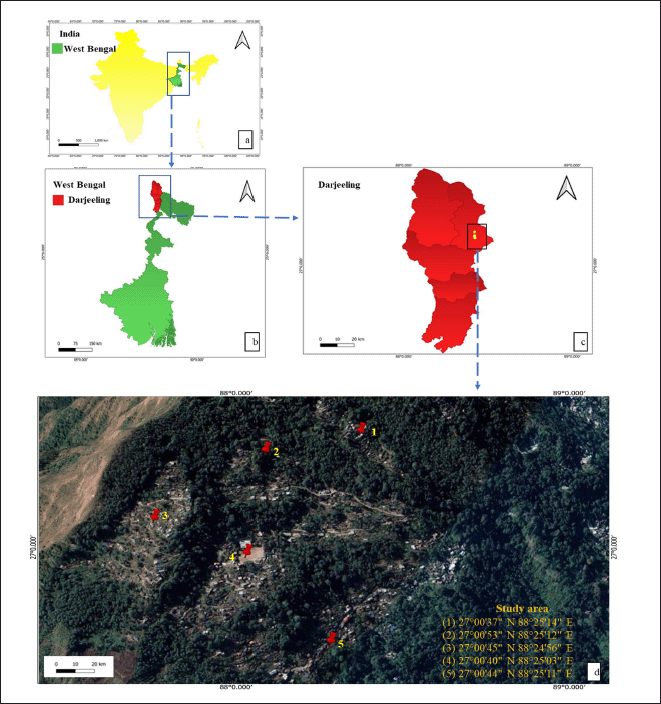 | Figure 1. Map (a–d). a) The map showing the geographical location of West Bengal in India. b) Geographical location of Dajeeling district in West Bengal. c) The map of surveyed area. d) Map depicting the various villages visted during the present study in Teeta valley, Dajeeling district, West Bengal. (The map is created using Qgis software and Google earth pro.) [Click here to view] |
Importance value
IVs is the proportion of informants who consider a species (s) as most important to the sum of number of respondents and was calculated as follows:
The IVs is the proportion of informants (s) as most important and was calculated as follows:
where nis = number of informants (i) who regard the species (s) as the most important; n = total number of informants.
RESULTS
Socio-demographic profile of the informants
Altogether 28 persons have been selected as informants from the study area and information on traditional phytotherapy knowledge were collected by interrogating the informants. Out of total number of informants interviewed, 22 individuals were medicine men who acted as key-informants and rest 6 are knowledgeable persons who served merely as informants. A list of total informants along with their name, address, age, marital status, ethnicity, educational status, and their category has been prepared and presented in tabular form (Tables 1 and 2). Sociodemographic profiles of the informants show that all the informants are tribal and majority of them (about 57.14%) belong to the Limbu community, followed by Rai and Tamang communities (about 21.43% each). The percentage of the males is 75% (21 persons), and only seven informants were found to be female (25%) who regularly practice ethnomedicine. Among the informants, 12 persons belong to the age group of 40–60 years (42.81%), 16 informants are above 60 years of age (57.14%), but no younger informants (belonging to the age group of 20–39 years) are found familiar with plants used as medicine. In respect of their educational status, out of 28 informants, 13 individuals are illiterate (46.42%), and the rest 15 are literate (53.57%). Narendra Subba, a graduate who teaches in a government primary school, has the highest educational qualification among the informants. However, the education standard among the informants is not high due to their poor economic conditions.
Ethnomedicinal knowledge and phytoresources
The plant species were arranged and presented in alphabetical order along with their family name, followed by voucher number, vernacular name, plant part(s) used, diseases cured, mode of administration, scores of IVS and FL% (Table 4).
Reported medicinal plants, dominant plant families, and plant habit
A total of 74 ethnomedicinal plants have been collected from the study sites of Teesta Valley. These 74 recorded taxa spread over 44 families, 68 genera, and 74 species (Table 3). The dicot family Rosaceae was represented by the greatest number of plant species (five species, 11.36%) followed by Asteraceae and Zingiberaceae (four species each, 9.09%), Anacardiaceae, Lauraceae, Poaceae, Solanaceae, Moraceae and Lamiaceae (three species each, 6.81%), Fabaceae, Malvaceae, Amaranthaceae, Saxifragaceae, Phyllanthaceae, Apiaceae, Urticaceae, Rubiaceae and Combretaceae (two species each, 4.54%).The remaining 26 families had single species representation (2.27% each) (Fig. 2).
According to the habit of the plants, the reported taxa fall under four groups namely trees, shrubs, herbs, and climbers (Fig. 3). The herbaceous flora exhibit the highest contribution of 30 species (40.54% of total plant species), then trees of 23 plant species (31.08%), shrubs 16 (21.62%), and climbers 5 (6.75%).
Plant part(s) used
In the present study, it was observed that the leaf was the maximally utilized plant part accounting for 30.77% of medicinal recipes followed by the underground part (23.08%), bark (16.49%), fruit (13.19%), stem (5.49%), flower (4.4%), seed (3.29%), whole plant (2.19%), and resin (1.1%) (Fig. 4).
Disease categories
Based on the diseases classification of Cook (1995) the recorded 42 diseases have been grouped into 11 disease categories (Table 5) like digestive system disorders, genitourinary system disorders, respiratory system disorders, musculo-skeletal system disorders, etc. It has been observed that maximum number of medicinal plant species (27 species) were used in the case of digestive system disorders. For respiratory system disorders 22 species were prescribed, followed by 10 numbers of species used in the musculo-skeletal system disorders, 8 plant species were used in circulatory system disorders and endocrine, nutritional or metabolic disorders, etc.
Use of drugs in various forms
In present study, knowledgeable persons collected fresh plant ingredients from various sources (wild and commercial). Among the 74 documented species of plants, 41 plant species have been collected from wild sources which show the richness of medicinal flora in the wild and highlights the dependency of local people on wild plant sources. Apart from it, 24 plants are cultivated locally in the area and ingredients of nine plant species are bought from commercial establishments and markets in the locality.
A total of 81 remedies are applied for treating 42 types of diseases. Majority (85%) of the remedies were prepared from fresh materials. Some remedies were prepared from dried materials (10%) only and few were prepared from dried or fresh plant materials depending upon their accessibility in the area (5%).
The informants gave data about 81 monoherbal preparations of plant species for treating 42 different types of diseases. It was observed that informants in the surveyed region follow various ways of remedy preparation which depend on type of disease treated. The major modes of remedy preparations were juice (37.92%) followed by decoction (32.75%), paste (24.14%), and smoulder (5.17%) (Fig. 5).
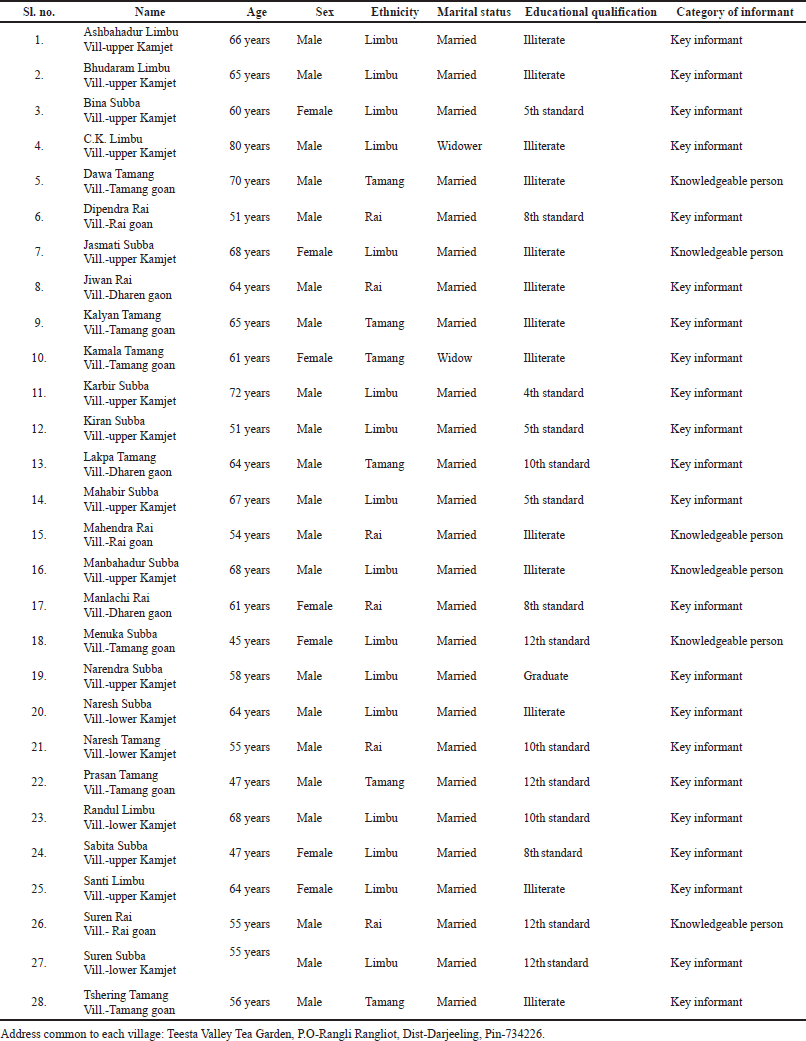 | Table 1. List of the informants and their sociodemographic information (n = 28). [Click here to view] |
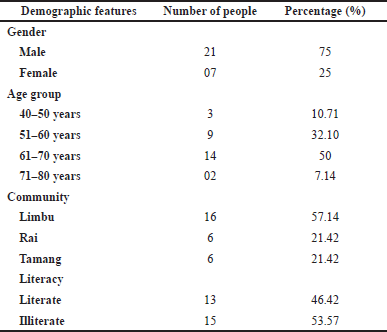 | Table 2. Summary of the sociodemographic profile of the informants (n = 28). [Click here to view] |
 | Table 3. Number of families, genera, and species recorded. [Click here to view] |
Method of administration and doses
Approximately 72.60% of drugs were administered in oral form. Remedies are applied in form of paste, juice, decoction, powder, etc. About 21.92% folk remedies followed topical route as massage, paste, etc., followed by 4.11% nasal inhalation and 1.37% by tooth brushing. The medicinal plant species used as sniffing are burnt to inhale fumes. The leaf and bark of some plant species are boiled and decoction is taken against body pain, fever, cough, diarrhea, and dysentery etc.
The informants used common measuring units like teaspoons, cups, pinch, and fingers, etc., unlike scientific measuring units like, millimeter (mm), milliliter (ml), gram (gm), etc. This traditional method of measuring helps ethnic herbalists greatly in calculating the quantity of plant materials needed for remedy manufacturing and determining the correct dosage of medication to give to a patient for efficient treatment (Cunningham, 2001). There was agreement among informants in terms of measurement or units but doses varied from diseases to diseases, health condition, and physical state of the patient.
Statistical analysis
The data were analyzed by employing the three quantitative indices like Fic, FL%, and IVs to get more objectivity in the present investigation.
Informant consensus factor
Fic is a very preferred index employed in ethnobotany research to highlight the extensively used plants for a specific disease category. The Fic values of 11 disease categories ranged between 0.7 and 0.83. Among the categories of disorders, the digestive system disorders secured the highest Fic value (0.83) which means there is a greater consensus among informants regarding the use of the 27 prescribed plants for this disease category. The least Fic value was calculated in case of certain infectious or parasitic disorders (0.7). Here, respiratory system disorders obtained Fic value of 0.81, followed by 0.8 value obtained in the two disease categories [injury/infestations and ear, nose, eyes, and mouth (ENEM) disorders], and endocrine and nutritional or metabolic disorders (0.79), etc. (Table 5).
Fidelity level
FL% values of the recorded 74 plant species ranged from 36% to 92.8%. Highest FL% value (92.8%) was recorded for two plant species Drymaria cordata (L.) Roemer & Schultes (throat pain, sinuses) and Zingiber officinale Roscoe (throat pain, cold and cough). The lowest FL% was observed in Acmella paniculata (Wall. ex DC.) R.K. Jansen, used to treat toothache (Table 4).
Importance value
After analyzing the data, it was found that IV of the plants ranged from 0.28 to 1 (Table 4). The highest IVs i.e., 1 was recorded for three species, namely, Artemisia nilagirica (C.B. Clarke) Pamp. (nose bleeding and mouth ulcer), Centella asiatica (L.) Urb. (tonsillitis), and Terminalia chebula Retz. (hypersensitivity and throat pain). Other three plants species secured the IVs of 0.96, such as D. cordata (L.) Willd. ex Schult. (throat pain, sinuses, tonsilitis), Curcuma longa L. (for curing cough, cold), and Terminalia bellirica (Gaertn.) Roxb. (cough, cold, and bronchitis). The lowest IVs, i.e., 0.28 was calculated for two species of medicinal plants namely Aeschynanthus parviflorus (D.Don) Spreng. (used for fever) and Baccaurea ramiflora Lour. (for constipation).
DISCUSSION
The current investigation embodies the information on 74 medicinal plants distributed in 44 families of angiosperms and pteridophytes which are utilized by the informants in the study region. According to the findings, people in the area have been using plant resources to treat a variety of diseases. Through personal experience, ancestral prescription, and long history of utility, the locals are familiar with valuable plants and recipe preparation. A total 81 monoherbal formulations are prepared by the informants. It clearly indicates the richness of ethnomedicinal plants and wider knowledge domain on folk herbal knowledge among the local people in the study area.
Among the recorded 44 families, highest number of species was recorded from Rosaceae family. The five species recorded in this family fall in three types of growth forms, namely, tree (two species), shrub (two species), and herb (one species). The dominance in the number of used plant species in the family Rosaceae may be because of their medicinal or therapeutic properties and also their wide distribution in this region of Teesta Valley.
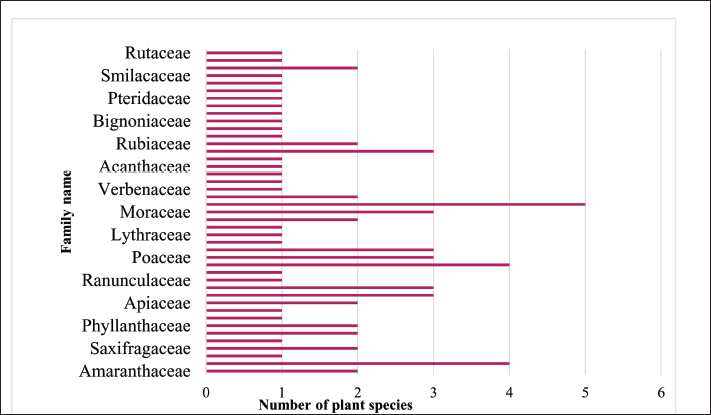 | Figure 2. Number of plant species in respective family. [Click here to view] |
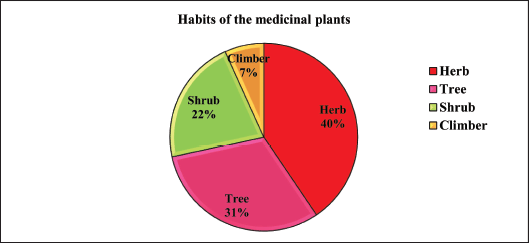 | Figure 3. Habits of medicinal plants in the study area. [Click here to view] |
The present study elucidates that the herbs (40.54%) are dominantly used in the region for curing various diseases followed by trees (31.08%). The possible reason for using the herbaceous form in highest number is that herbs are abundantly grown and easily available in the locality (Mandal and Rahaman, 2022). In addition, herbs are more easily gathered than tree species as it is shorter in height and smaller in size. It is the reality that people tend to look for food and therapeutic plants that are plentiful, simple to acquire, and accessible all year round (Albuquerque et al., 2005).
Folk medical practices are mostly based on wild-growing plants, and the use of local wild plants is still practiced in all ethnic cultures. The majority of the therapeutic plant species were obtained by local people from natural sources, demonstrating the local people’s reliance on plants growing in the wild.
In the present study, informants mostly prefer leaf (30.77%) for the preparation of their herbal drug that is followed by root (23.08%). Leaves are frequently used as it is readily accessible than other parts of the plant. In addition, leaves are the main sites for the production of many bioactive secondary metabolites (Gonçalves and Martins, 1998; Rahaman and Karmakar, 2015). In previous studies, it has been reported that leaves were the mostly used plant part (Rahaman and Karmakar, 2015; Swargiary et al., 2020) in India. Therapeutically active various phytochemicals belonging to the classes of alkaloids, tannins, phenolics, terpenoids, vitamins, minerals, and others are stored in the foliage of medicinal plants which explains the basis for ethnic herbalists’ dependence on leaves (Yineger et al., 2008). In several earlier works, it was illustrated that leaves are the most used part for the preparation of traditional recipes for treating various diseases (Biswakarma et al., 2017; Mussarat et al., 2014; Tangjitman et al., 2015; Umair et al., 2017).
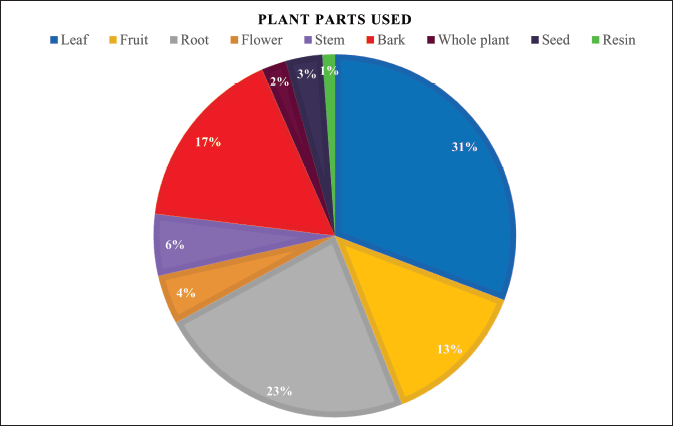 | Figure 4. Plants parts used in herbal preparations. [Click here to view] |
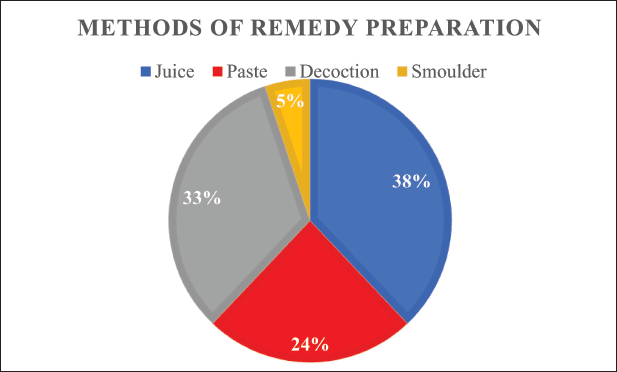 | Figure 5. Methods of preparations of ethnomedicine. [Click here to view] |
 | Table 4. List of medicinal plants used by the ethnic people of Teesta valley. [Click here to view] |
From this study, it is noticed that digestive system disorders are most prevalent in this surveyed area. There are various kinds of digestive system disorders recorded like stomach pain, constipation, diarrhea, indigestion, etc. Stomach disorders such as stomach ache, indigestion, constipation, dyspepsia, and flatulence have been documented in both rural and urban areas across the globe (Anh et al., 2011; Bhandari et al., 2009; Biswakarma et al., 2017).
From the above result, it is found that the major method of remedy preparation is juice (37.92%) followed by decoction (32.75%). Juice may be preferred because of its simple way of preparation and efficacy (Singh et al., 2017). It also might possibly be because juice has a greater concentration of active components than other dose forms like decoction, paste and powder (Yaseen et al., 2015).
When required, the majority of the dosage forms were made fresh. The informants believe that while using fresh components in remedy formulation, the effectiveness potential of the substances is more, which they believe it would be reduced if the items were dried. The fact that both fresh and dried forms are employed in the manufacture of remedies gives the informants a higher chance of having access to the materials used in medicinal formulations throughout the year.
 | Table 5. Informant consensus factor (Fic) for each disease category. [Click here to view] |
In statistical analysis, the highest Fic value was found in the case of digestive system disorders. The plant species with the highest Fic score can be recognized as valuable in the development of evidence-based phytomedicine (Rahaman and Karmakar, 2015). Also, many researchers have determined that high consensus species are very suitable for phytochemistry and pharmacology research (Heinrich, 2000; Trotter and Logan, 1986).
The highest FL% is recorded in the case of D. cordata and Z. officinale. The plants with high FL% might be considered the most potential candidates for the treatment of particular diseases. Plants with the highest FL% rating might be studied further phytochemically to find out what bioactive chemicals are responsible for their great healing capacity (Tariq et al., 2015).
The highest IVs is found in C. asiatica (L.) Urb., A. nilagirica (C.B. Clarke) Pamp., and T. chebula Retz. The plants having the highest IVs score indicate that they are therapeutically very significant and may be considered as a suitable candidate for natural product development program.
CONCLUSION
According to the current study, a total of 74 potential ethnomedicinal plants were recorded which cure 42 varieties of diseases. This highlights a very rich traditional knowledge base among the ethnic groups of Teesta Valley of Darjeeling district and will certainly enrich the ethnomedicinal database of this area as well the State of West Bengal. It has been found from the study that diseases of the digestive system are prevalent in this region and its remedial traditional knowledge depends upon 27 medicinal plant species. It indicates the rich alternative options of medicinal plants and the resilience strength of traditional knowledge for treating digestive system disorders. The plants which are maximally used in curing a particular disease category should be exploited further in order to develop a cost-effective supply of medicine for the benefit of mankind. This study will also be instrumental in documentation and preservation of knowledge of ethnomedicine prevalent in the study area which is passed from generation to generation only in the oral form.
ACKNOWLEDGMENTS
The authors are grateful to all the tribal informants who exchanged their knowledge regarding the ethnomedicinal uses of various plants with us. This study could not have been possible without their active help and support. The authors also like to thank the Head, Department of Botany (UGC-DRS-SAP & DST-FIST sponsored), Visva-Bharati, Santiniketan for necessary laboratory facilities. Two authors (YS & SH) acknowledge the University Grant Commission, India for financial assistance sanctioned in the forms of UGC-NET JRF and non-NET research fellowship.
AUTHORS’ CONTRIBUTIONS
Chowdhury Habibur Rahaman, Yasodha Subba, and Samik Hazra have conceptualised and designed the present research work. Yasodha Subba visited the study areas and collected all the information. Yasodha Subba and Samik Hazra interpreted and analyzed the data, prepared the figures, maps and drafted the manuscript after consulting with Chowdhury Habibur Rahaman. Chowdhury Habibur Rahaman has critically revised the manuscript and corresponded this. All the authors consented to submit their work to the present journal; approved the present version for publication and agree to be responsible for all facets of the work. All the authors are eligible to be an author as per the International Committee of Medical Journal Editors requirements/guidelines.
CONFLICT OF INTEREST
The authors declare that they have no conflict of interest.
ETHICAL APPROVALS
This study does not involve experiments on animals or human subjects.
DATA AVAILABILITY
All data generated and analyzed are included within this research article.
PUBLISHER’S NOTE
This journal remains neutral with regard to jurisdictional claims in published institutional affiliation.
REFERENCES
Albuquerque UPD, Andrade LDHC, Silva ACOD. Use of plant resources in a seasonal dry forest (Northeastern Brazil). Acta Bot Bras, 2005; 19(1):27–38. CrossRef
Anh DD, Lopez AL, Thiem VD, Grahek SL, Duong TN, Park JK, Kwon HJ, Favorov M, Hien NT, Clemens JD. Use of oral cholera vaccines in an outbreak in Vietnam: a case control study. PLoS Negl Trop Dis, 2011; 5(1):e1006. CrossRef
Bhandari GP, Dixit SM, Ghimire U, Maskey M.K. Outbreak investigation of diarrheal diseases in Jajarkot. J Nepal Health Res Counc, 2009; 7(2):66–8. CrossRef
Biswakarma S, Pala NA, Shukla G, Chakravarty S. Ethnomedicinal plants used to cure stomach disorders in forest fringe communities in northern part of West Bengal. Indian J Nat Prod Resour, 2017; 8(4):370–80.
Byg A, Balslev H. Diversity and use of palms in Zahamena, Eastern Madagascar. Biodivers Conserv, 2001; 10(6):951–70. CrossRef
Census of India. Series-20 Part-XII A-district census handbook, Darjeeling-village and town wise primary census abstract (PCA). Census of India, West Bengal, India, 2011.
Cunningham AB. Applied ethnobotany: people, wild plant use and conservation. Earthscan Publication Ltd, London, UK, 2001.
Das AP. Floristic studies in Darjeeling hills. Nelumbo, 2004; 46(1–4):1–18.
Das AP. Diversity of angiospermic flora of Darjeeling hills. In: Pandey AK (ed.). Taxonomy and biodiversity, CBS Publisher and Distributor Private Ltd, New Delhi, India, pp 118–127, 1995.
Tongco MDC. Purposive sampling as a tool for informant selection. Ethn Res Appl, 2007; 5:147–58. CrossRef
Friedman J, Yaniv Z, Dafni A, Palewitch D. A preliminary classification of the healing potential of medicinal plants, based on a rational analysis of an ethnopharmacological field survey among Bedouins in the Negev Desert, Israel. J Ethnopharmacol, 1986; 16:275–87. CrossRef
Ghosh DK, Mallick JK. Flora of Darjeeling Himalayas and foothills (Angiosperms). Bishen Singh Mahendra Pal Singh, Dehra Dun, India, 2014.
Gonçalves MIA, Martins DTO. Medicinal plants used by the population of the municipality of Santo Antônio de Leverger, Mato Grosso, Brasil. Rev Bras Farmacogn, 1998; 79(3–4):56–61.
Hara H. The flora of Eastern Himalayas, reprint vols. I. and II. Bishen Singh Mahendra Pal Singh, Dehradun, India, 2008.
Heinrich M. Ethnobotany and its role in drug development. Phytother Res, 2000; 14(7):479–88. CrossRef
Jain SK. A manual of ethnobotany. Sci Publishers, Jodhpur, India, 1987.
Jain SK, Mudgal V. A hand book of ethnobotany. Bishen Singh Mahendra Pal Singh, Dehra Dun, India, 1999.
Jain SK, Rao RR. A handbook of field and herbarium methods. Today and Tomorrows Publishers, New Delhi, India, 1997.
Karmakar S, Rahaman CH. Ethnomedicinal practices of the Santal tribe living around Biharinath Hill in the district of Bankura, West Bengal, India. Res J Agril Sci, 2022; 13(1):028–36.
Mandal SK, Rahaman CH. Inventorization and consensus analysis of ethnoveterinary medicinal knowledge among the local people in Eastern India: perception, cultural significance, and resilience. Front Pharmacol, 2022; 13:861577. CrossRef
Moktan S, Das AP. Ethnomedicinal approach for diarrhoeal treatment in Darjeeling district (WB), India. Ethnobotany, 2013; 25:160–3.
Moktan S, Rai P. Ethnobotanical approach against respiratory related diseases and disorders in Darjeeling region of Eastern Himalaya. NeBIO, 2019; 10(2):99–105.
Mussarat S, AbdEl-Salam NM, Tariq A, Wazir SM, Ullah R, Adnan M. Use of ethnomedicinal plants by the people living around Indus River. Evid-based Complement Altern Med, 2014; 892947:1–14. CrossRef
Noltie H.J. Flora of Bhutan: including a record of plants from Sikkim and Darjeeling. Royal Botanic Garden Edinburgh, Edinburgh, UK, 1994.
Payyappallimana U. Role of traditional medicine in primary health care: an overview of perspectives and challenging. Yokohama J Soc Sci, 2010; 14(6):57–77.
Pradhan DK, Ghosh J. New ethnomedicinal information from Lepcha community of Dzongu, Sikkim. Explor Anim Med Res, 2021; 11(2):179–87. CrossRef
Rahaman CH, Karmakar S. Ethnomedicine of Santal tribe living around Susunia hill of Bankura district, West Bengal, India: the quantitative approach. J Appl Pharm Sci, 2015; 5(2):127–36. CrossRef
Rai SK, Bhujel RB. Note on some less known ethnomedicinal plants from the Darjeeling Himalayas. In: Ghosh C, Das AP (eds.). Recent studies in biodiversity and traditional knowledge in India. Gour Mahavidyalaya, Malda, India, pp 321–27, 1999.
Ranjan V, Lakshminarasimhan P, Dash SS, Chowdhery HJ. Flora of West Bengal. Apiaceae to Boraginaceae. Botanical Survey of India, Calcutta, India, vol. III, 2016.
Shankar Y, Moktan S, Das AP. Ethnomedicinal approach by the Lepcha tribe of Kalimpong area in Darjiling Hills. In: Mondal N, Sen J (eds.). Nutrition and health among tribal populations of India—a bio-cultural approach, BR Publishing Corporation, New Delhi, India, pp 121–34, 2016.
Singh A, Nautiyal MC, Kunwar RM, Bussmann RW. Ethnomedicinal plants used by local inhabitants of Jakholi block, Rudraprayag district, Western Himalaya, India. J Ethnobiol Ethnomed, 2017; 13(1):1–29. CrossRef
Swargiary A, Daimari M, Roy MK. Survey and documentation of anthelmintic plants used in traditional medicine system of tribal communities of Udalguri district of Assam, India. J Appl Pharm Sci, 2020; 10(1):046–54. CrossRef
Tangjitman K, Wongsawad C, Kamwong K, Sukkho T, Trisonthi C. Ethnomedicinal plants used for digestive system disorders by the Karen of Northern Thailand. J Ethnobiol Ethnomed, 2015; 11(1):1–13. CrossRef
Tariq A, Mussarat S, Adnan M, Abd_Allah EF, Hashem A, Alqarawi AA, Ullah R. Ethnomedicinal evaluation of medicinal plants used against gastrointestinal complaints. Bio Med Res Int, 2015; 892947:1–14. CrossRef
Trotter RT, Logan MH. Informant consensus: a new approach for identifying potentially effective medicinal plants. In: Etkin NL (ed.). Plants in indigenous medicine and diet, behavioural approaches, Redgrave Publishing Company, Bredfort Hills, NY, pp 91–112, 1986. CrossRef
Umair M, Altaf M, Abbasi AM. An ethnobotanical survey of indigenous medicinal plants in Hafizabad district, Punjab-Pakistan. PloS one, 2017; 12(6):1–22. CrossRef
Yaseen G, Ahmad M, Zafar M, Sultana S, Kayani S, Cetto AA, Shaheen S. Traditional management of diabetes in Pakistan: ethnobotanical investigation from traditional health practitioners. J Ethnopharmacol, 2015; 174:91–117. CrossRef
Yineger H, Yewhalaw D, aTeketay D. Ethnomedicinal plant knowledge and practice of the Oromo ethnic group in Southwestern Ethiopia. J Ethnobiol Ethnomed, 2008; 4(1):1–10. CrossRef
Yonzone R, Lama D, Bhujel RB. Medicinal orchids of the Himalayan region. Pleione, 2011; 5(2):265–73.